Mission to Munch Identity Series: A History of Czech Kolache + Kolache and Klobasniky Recipes
Long Article Alert: If you are here only for the Kolache and Klobasniky recipes click here to skip to the recipe.
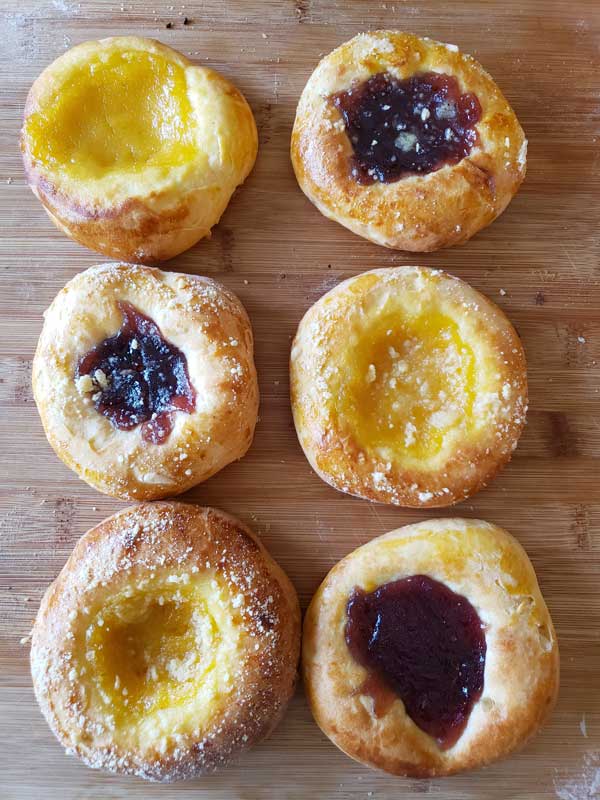
This past holiday season, I became obsessed with kolache. I do a lot of baking during the holidays and try to bake something new every Christmas. This year, shortly before the holidays got underway, I rediscovered the Bohemian American Cookbook by Marie Rosicky. It was a cookbook that had been passed down to me from my Great-Grandmother. GG, as we called her, wasn’t Czech (she was Austrian-Hungarian and Scottish); my Great-Grandfather, who passed away before I was born, was first generation Czechoslovakian. While I don’t know exactly how she came to be in possession of the cookbook, I imagine she used it to make Czech meals for her husband and family. Each grandchild received a copy of the cookbook and that is how it was eventually passed down to me through my dad.
Note: Without getting too deeply into European history, the Kingdom of Bohemia is now the modern-day Czech Republic, formerly Czechoslovakia until 1993. It was known as Bohemia until 1918.
The Bohemian American Cookbook was originally published in 1915 in Omaha, Nebraska (I have the 1925 reprint). The fact that the cookbook was reprinted numerous times highlights the importance of the recipes as staples in the Czech community that had settled in Nebraska. Marie Rosicky (also spelled Rosicka on some editions), a Czech immigrant herself, shared both traditional Czech as well as American recipes for the housewife living between two worlds. Because of the age of the cookbook, I had always viewed it as more of an heirloom to be admired and not as a viable source of recipes. In the past, I had placed a green post-it-note on the recipe for Bohemian tarts, or kolache (koh-lah-chay). Kolaches, as we Americans like to call them (Kolache (koláče), is actually plural in Czech with kolach (koláč) being singular. They are made with a lightly sweetened yeast dough with a topping in the center. Traditionally, the toppings were plums, poppy seeds, or farmer’s cheese, but also jams, and, an American adaptation, cream cheese. They could sometimes have a crumbly topping called popsika sprinkled over the top as well. I decided it would be fun to connect with the Czech side of my cultural heritage through food and make kolache for Christmas. Focused on the fun of discovery, I wasn’t quite prepared for the emotional journey I would go on – from feeling like a failure when my first batch didn’t turn out, to pouring over hundreds of recipes that featured regional variations, all of which further helped to emphasize the genuine pride for kolache in American Czech communities. I also learned that kolache were more a part of my identity than I had originally understood, as both sides of my family come from regions in which kolache are important. What began as nothing more than a fun cooking project became transformative as I learned about the power of the kolache as a symbol of Czech identity. In the end, I gained so much more than a workable kolache recipe. I gained knowledge, perspective, and a more deeply rooted sense of identity shaped by connections to those who came before me.
Kolache From the Old Country

There are several types of kolache: the medium-sized round cakes we in America most often associate with kolache, miniature wedding kolache (Svatební kolacky), large, almost pizza like kolache called frgale, and Morovian kolache (a regional variety that is essentially double stuffed with filling encapsulated inside the dough and then placed on top like regular kolache) (Childs, Binkovitz). The variations within this signature pastry are exemplified by the sheer number of eastern European breads that sound very similar. When yeast breads enriched with butter, eggs, and sugar arrived in Eastern Europe in the 15th century, the word kolo, the Slavic word for wheel, was applied to any round sweetened yeast bread used across Eastern Europe, this led to “the Polish kolacz (pronounced kowatch), Russian kulich, Ukrainian kolač, Serbo-Croatian kolač, Hungarian kalacs, and Yiddish koyletch (an early synonym for egg challah, considered a cake by Sephardic Jews)” (Marks).
While the doughs use similar ingredients, most of the varieties were plain, which is where the recipes from Bohemia, Moravia, and Slovenia diverged (Marks). By the 18th century, bakers were indenting the dough and filling them with plum butter before baking (Marks). Poppy seed and cheese fillings grew popular and, therefore, are often considered the more traditional flavors that were brought over to America by Czech immigrants. By the 19th century, Americans were substituting cream cheese or farmer’s cheese and using more modern fillings like cherry, lemon, and blueberry, as well as an optional streusel topping called
Note: Food historian Gil Marks refers to the streusel topping as
Kolache Take America

From an American perspective, kolache are often seen as the Czech national food, and while kolache are certainly a much-loved staple of the country, a modern Czech may be just as likely to mention knedlíky (dumplings) or Guláš (goulash), over kolache. So why are kolache so synonymous with Bohemian American culture? Czechs began immigrating to America in the 19th and 20th centuries. The first significant wave began in 1848, after a failed revolution against the Austrian Empire, which the Kingdom of Bohemia had become a part of in 1815 (Ference). After the initial wave, many Czech and Eastern Europeans immigrated to America for cheap land (Fereance). These populations largely settled in the Midwest: Nebraska, Minnesota, Wisconsin, Iowa, and Illinois, as well as Texas, where the largest Czech community in America still resides today (Marks). By 1914, around 350,000 Czechs had immigrated to America (Ference).
While many Czech immigrants ate American food, they also held on to traditions from the old country, the Bohemian American Cookbook being historical proof of this. Even so, life in America was different. In Europe, ovens were rare, while in America they were common. In Europe, sugar, butter, eggs, and white flour were expensive; in America, they were cheap. These factors meant that in “the old country” kolache were only made for special occasions: Epiphany, masquerades and dances, or Mardi Gras and pre-Lenten festivities. Newly engaged women sent small wedding kolache to family and friends as a wedding invitation (Marks). Now, with ovens and cheap ingredients readily available, kolache became common, no longer reserved for special occasions, but serving as a surrogate comfort food and symbol of Czech culture (Marks). “Czechs in America enjoyed their coffee with kolache, becoming a way of entertaining neighbors and making more bearable the hardships and isolation of farm life” (Marks).
The Texas Kolache
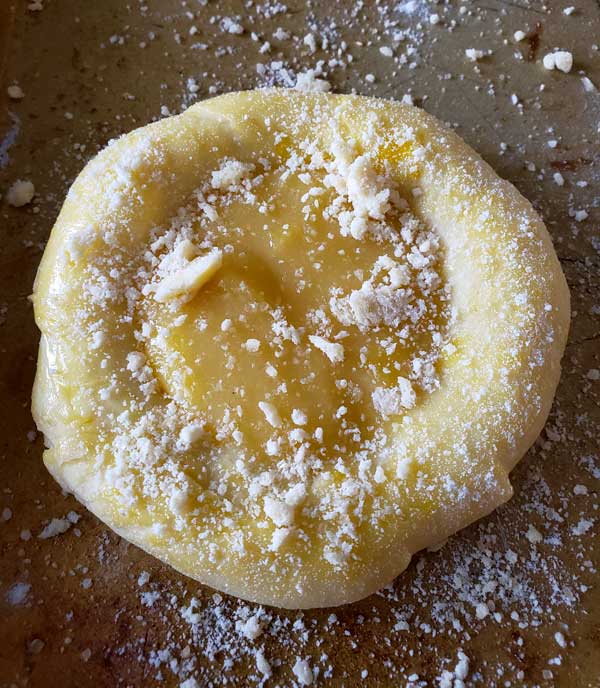
I made my first batch of kolache for Christmas, following the Bohemian American Cookbook and adapting a recipe to modern measurements. However, this first attempt produced kolache that were more dinner roll than sweet dough. Perhaps I over-proofed them, but after looking at the recipe again, I realized that I had used a variation recipe and not the regular kolache. This sent me back to the drawing board, looking up other recipes to verify and help me adapt the recipe in my book to a recipe that a modern baker could use. Anyone researching kolache, especially how to make the best kolache, will find it impossible to avoid the Texas version. That’s because Texas and kolache have almost become synonymous in America. It makes sense, the largest Czech settlement in America, also known as the Czech belt, is in Texas. This group of Czechs are mostly located in East and Central Texas with the most famous of these towns (at least in terms of kolache) being a town called West (Sedacca). Ironically, it was at this time in my kolache obsession that I realized the divergent path kolache take from their old-world counterparts (becoming bigger, and as a Texan would argue, better), is also a part of my identity. While my Czech DNA is of the Nebraska variety on my dad’s side, my mom is a Texan. Although not Czech, she grew up eating kolache as a part of social and church events. I, too, am a Texan by birth, but I didn’t live in Texas long enough to have familiarity with the pastry. My mom began to help me do research on kolache, pulling out her Texas cookbooks, church cookbooks, and reading up on kolache on the internet; it was she who discovered the most Texan of all kolache, the klobasniky.

Texas is a foodie state, but more than that, it’s a state that embraces the rich food traditions of the many diverse cultures that inhabit its boundaries. Even though I spent my formative years in Minnesota, I grew up eating Tex-Mex, that unique fusion of Mexican cuisine combined with Texas-style cookery. Similarly, Texas embraced Czech culture, creating a Tex-Czech cuisine that is all its own. The Texas kolache
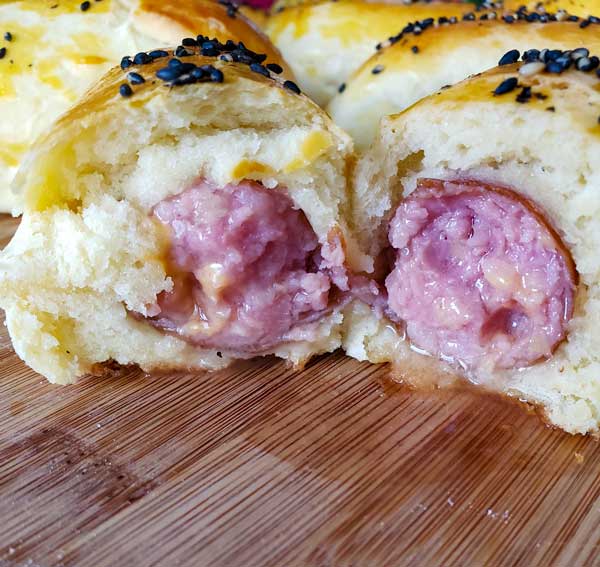
The spread of kolache culture can be credited to roadside shops. Because of these roadside stops, “many Texans, no matter their heritage, now consider kolaches road food, best purchased at a Czech Belt rest stop” (Edge). One of the most famous of these roadside stops is Village Bakery in West, Texas. Village Bakery was opened in 1952, by Georgia Montgomery (a Czech descendant) and her husband, and was the first store on record to sell kolache to the public (Cantrell). They sold traditional fillings like cheese, apricot, apple, prune, poppy seed, peach
How Do You Kolache?
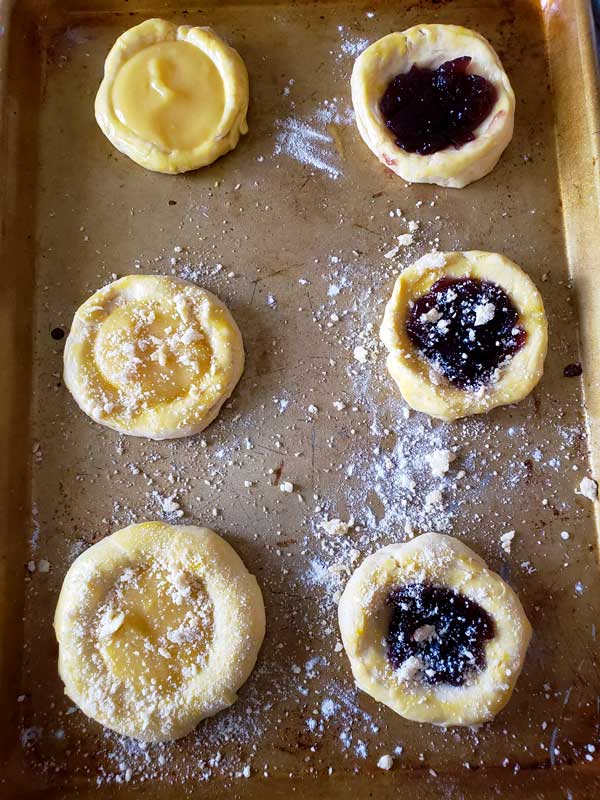
Clearly, kolache are a food ripe for transformation and innovation. Even the kolache from the old country had regional and event-based variations. My Bohemian American Cookbook shares three recipe variations. While it is a food tied to a rich cultural heritage, it’s only natural that kolache has evolved since coming to America. Czech families are fiercely protective of their family recipes, many have one passed down from generation to generation, and everyone has their own opinions on what makes the best kolache. From my research, there seems to be a great divide, with Americans knowing and preferring what has come to be known as the Texas Kolache and the more traditional kolache coming in second. But what are the differences?
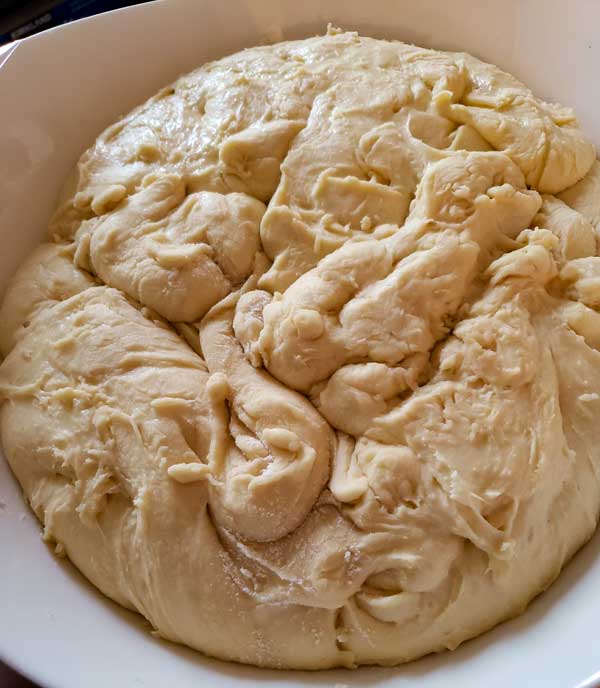
A Texas kolache is dense not fluffy, and it’s very buttery; whereas by contrast, Czech kolache are “airier, more modest affairs, lightweight rounds of egg-washed and oven-tanned bread” (Childs). Some doughs have lemon peel or a dash of spice, some don’t. Some recipes melt the butter first, some don’t. And some recipes proof the dough up to three times, while others rise only once or twice. Texas kolache may be rectangular, more traditional kolache are round. There are plenty of other variations, including how the eggs are added, or if there is icing or streusel toppings. All in all, it’s really up to the baker to determine personal preferences. I like to think that as kolache were traditionally baked by brides as invitations to weddings, the family kolache recipe is personal to each bride, a rite of passage, not only for the daughter to learn to bake the kolache from her female relatives, but also to add her own spin to it as she moves into a new stage of life.

My own kolache journey saw me baking kolache 4 times between Christmas and New Year’s Day. My family blames me for weight gain, but as my brother said, “I’m glad you decided to find yourself through food.” My dad’s family does have their own recipe (closer resembling the Texas Kolache), and my Nebraska aunts were lucky enough to learn to make kolache from my GG, like other Czech women of the past. But for me, I’ve had to make do on my own, using the cookbook gifted to me and tons of research. I tried both the family recipe and the one I adapted from the Bohemian American cookbook. My family likes the Bohemian-American version best. So, that’s now my kolache recipe and the one I will be sharing here.
Overall, I’ve learned that there are just as many opinions for kolache as there are varieties of kolache. As for this recipe, whether you can claim Czech heritage, or are simply a fan of the kolache, all are welcome here. Food is a wonderful expression of geography and culture, but culture isn’t static, and neither is food. Regional variations arise, tastes change. The foundation for a food tradition is not only in the technique of preparation, but also in the reason the food is embraced by the culture. Kolache have traveled across the Atlantic, becoming a global food. Modern kolache reflect that journey. Kolache have acted as a wonderful vehicle of cultural sharing and bonding, bringing communities and people together to delight in this deceptively simple pastry.
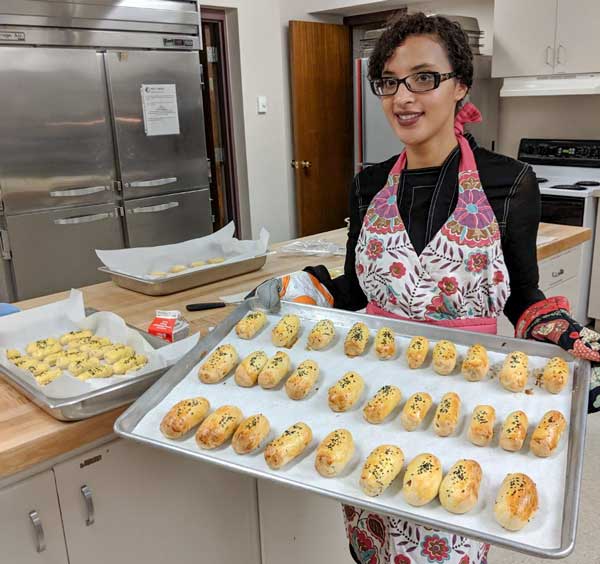
Final Note:
This article has been several months in the making. After having completed most of it, I found out that my grandfather passed away. While he wasn’t Czech, he enjoyed a good kolache, so it was suggested that I make kolache and klobasniky for the wake. Having just learned to make kolache in December, and having never made them in bulk, I was more than a little nervous. Beyond that, Nebraskans know a thing or two about kolache. Yet, just as I learned the enduring power of kolache as a symbol of the Czech culture, I found a sense of purpose in preparing what I saw as a tribute to my grandfather. My family helped me to make over 100 kolache and klobasniky for the wake. After all of the research that I had done for this article, I found it both novel and surprising that many of those with whom we interacted instantly knew we were making kolache, even without being told. And while the occasion for the kolache baking was a sad one, I am proud to say that my kolache passed inspection by all the Nebraskans who tasted them. So, while my grandfather and I weren’t super close, I want to dedicate this Mission to Munch recipe to my grandfather, Coach Pat Avey. With that, here is the recipe.
References:
Marks, Gil. “American Cakes: Kolache.” Tori Avey. August 20, 2013. https://toriavey.com/toris-kitchen/kolache/
Ference, Gregory C. “Czech and Slovakian Immigrants.” Immigrants to the United States. http://immigrationtounitedstates.org/455-czech-and-slovakian-immigrants.html
Cantrell, Katie. “A Trip Through Kolache History.” Edible Austin. 2008. http://www.edibleaustin.com/index.php/food-2/melting-pot/71-a-trip-through-kolache-history
Binkovitz, Leah. “Kolaches: The Next Big Thing in Pastries and The Tex-Czech Community Behind Them.” Smithsonian. April 5, 2013. https://www.smithsonianmag.com/arts-culture/kolaches-the-next-big-thing-in-pastries-and-the-tex-czech-community-behind-them-16375807/
Sadacca, Matthew. “Behold the Kolache, an Old World Pastry With Texas Pride.” Eater. February 15, 2016. https://www.eater.com/2016/2/15/10981356/kolache-texas-czech-pastry
Edge, John T. “The Kolache: Czech, Texan or All-American? (All Three).” New York Times. October 7, 2013. https://www.nytimes.com/2013/10/09/dining/the-kolache-czech-texan-or-all-american-all-three.html
Johnston, Abbey. “Eleven of the Kraziest Klobasniky (Not Kolaches!) in Texas.” Texas Monthly. September 2018. https://www.texasmonthly.com/food/eleven-krazy-klobasniky-kolaches-texas/
Kolache
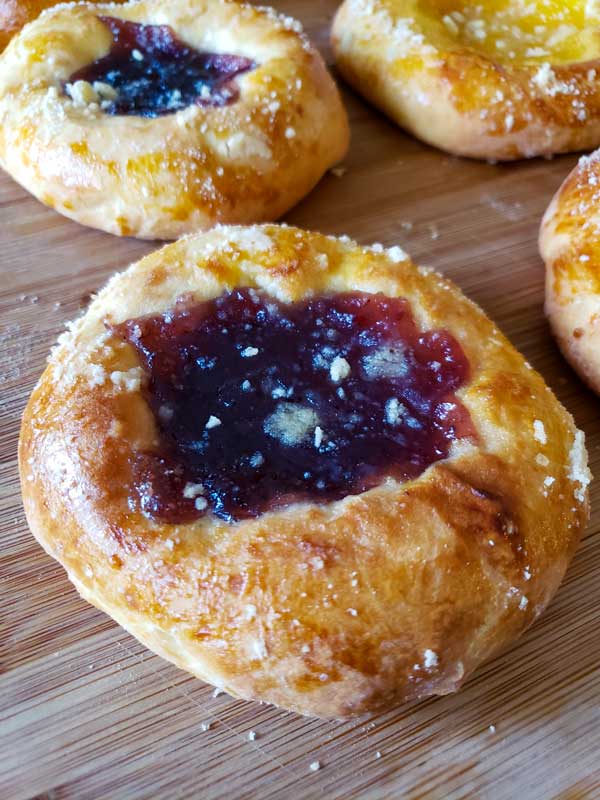
The recipes I’m sharing today have been adapted for the modern baker from the Bohemian American Cookbook. This version takes a little extra work, but ends up creating a pasty that is light and fluffy.
For the fillings, the kolache featured in the
Notes on This Recipe:
*This recipe calls for cream, feel free to use milk or mix milk and cream for half and half.
*The dough in this recipe is on the sticky side. Have extra flour ready for handling.
* I often don’t make all the kolache at once. You can freeze the dough to save for a rainy day. Once the dough has risen, form into balls and place in a Ziploc bag. You may wish to individually wrap the dough in plastic wrap to stop it from freezing together (a helpful extra step when thawing out.) When ready to make, let the dough thaw until malleable, and proceed with the rest of the recipe.
Ingredients
Yeast:
½ c lukewarm milk
2 ¼ tsp active dry yeast
1 tsp sugar
Dough:
1 c butter
½ c sugar
4 egg yolks
4 egg whites beaten stiff
2 c cream, milk, or half and half
5 ½ c flour and more for handling/dusting
1 lemon for zest
½ tsp. of vanilla
Dash of cinnamon
Dash of salt
Egg wash:
1 egg yolk
1 tbsp. cream or milk
Optional:
Powder sugar for dusting
Directions:
Separate the egg whites, putting the yolks in a small bowl and whites in a stand mixer. Whisk egg whites until stiff peaks form. Scoop into another bowl and set aside.
Cream butter in a stand mixer. Add sugar and four egg yolks one at a time until incorporated.
Add the egg whites to the butter, then add the yeast mixture, cream, vanilla extract, lemon zest, cinnamon, salt, and flour. Beat with a dough hook until the dough comes together and has an elastic quality but is still a bit runny. The dough is quite sticky, so you can coat your hands in flour and lift the dough from the bottom of the bowl and sprinkle more flour there then top the dough with a dusting of flour. You may wish to transfer to another bowl or leave it in the stand mixing bowl.
Set dough in a warm spot to let rise for about 1 hour, or until the dough has doubled in size.
While the dough is rising, make the egg wash by mixing one egg yolk and 1 tbsp. of cream/milk together in a small bowl. You may also prepare any additional filling and streusel topping if using (recipes below).
When the dough has doubled, flour your hands (I find it helpful to have an extra bowl full of flour to dip my hands into when needed) and take the dough out by the tablespoonful. Roll into a ball with your hands, then press into a cookie shape, using fingers to make an indent in the center of the dough. You can do this while holding the dough, or set the dough on a floured cutting board to do so.
Place a layer of parchment paper on a baking sheet, or coat the baking sheet with cooking spray. Place the indented kolache with about ½-1 inch of space in between them. With a basting brush, coat the rounded edges of the kolache with the egg wash. This ensures that the dough has a beautiful golden-brown color.
Fill the kolache center with your filling. Don’t forget you can mix and match fillings as well! Try a lemon curd and cream cheese filling, or a raspberry jam, lemon curd, and cream cheese filling. Get creative.
Once all the kolache are filled, sprinkle with streusel topping if using (recipe below). Let the kolache rise for 30 minutes.
Preheat the oven to 375F. When the kolache have risen, bake for 10-15 minutes.
Optionally, you can dust with powdered sugar immediately after taking out of the oven.
Streusel topping
3 tbsp flour
2 tbsp powdered sugar
1 tbsp butter
Directions:
Mix until crumbly.
Fillings
Cream Cheese Filling
16 oz room temperature cream cheese
½ c sugar
2 large egg yolk
2 tablespoon flour
1 teaspoon vanilla
Directions
Mix the ingredients and transfer to a bowl.
If not using right away, transfer to a bowl, then place in the refrigerator.
Cottage Cheese Filling
1 tbsp butter
1 lb cottage cheese
4 egg yolks
6 tbsp sugar
Zest of half a lemon
Dash of salt
½ c raisins
Directions:
Drain the cottage cheese thoroughly and pat dry. Cream a tablespoon of butter and cottage cheese. Add four beaten egg yolks, six tablespoons of sugar, the grated rind of half a lemon, a dash of salt, and half a cup of seedless raisins or blanched almonds cut into strips and mix.
If not using right away, transfer to a bowl, then place in the refrigerator.
Raspberry jam
1 c raspberries (or another berry)
½ c sugar
Directions:
Wash raspberries. Mash lightly in a pot and when they have boiled for about 5 min and juices are beginning to release, add half a cup of sugar to a cup of fruit. Boil for half an hour to 45 minutes, or until the jam becomes thick. Do the same for blackberry or strawberry jam.
If not using right away, then let cool in a bowl or jar, then place in the refrigerator.
Lemon Curd

1 tsp lemon zest
½ c lemon juice
½ c granulated sugar
3 eggs
4 tbsp butter cut in small pieces
Directions:
Whisk lemon zest, juice, sugar, and eggs in a medium saucepan. Add butter and cook over medium low heat whisk until thick enough to coat back of spoon or hold whisk marks about 6 minutes.
Strain the curd through a sieve into a bowl. Let cool. If not using right away, then cover with plastic wrap on the surface of the curd to prevent a skin from forming and place in the refrigerator.
P.S. any Leftovers are great for other desserts, toast, and scones!
Klobasniky
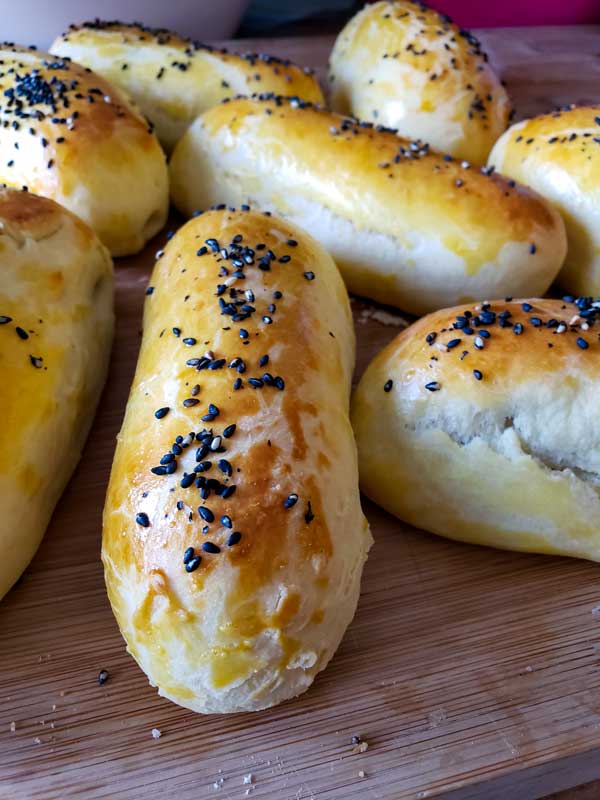
Klobasniky are made using the same dough as kolache. Follow the recipe above to make the kolache dough. When making kolache, I often reserve 8 balls of dough for klobasniky. As I mentioned previously, you can freeze the dough in balls and pull them out later to make either kolache or klobasniky.
Ingredients:
8 cheddar filled hot dogs or 2 kielbasa links (cut into 4ths) or sausage of choice
8 balls about 1-2 tbsp. of kolache dough (See above)
Egg wash (See above)
1-2 tbsp black sesame seeds or poppy seeds
Directions:
After kolache dough has risen, take a small ball of dough and wrap around the sausage, ensuring that there are no holes. Finish wrapping the remaining sausage. Coat the top of the klobasniky with egg wash, then sprinkle the tops with black sesame seeds or poppy seeds. Place on a greased baking sheet and let rise for 30 minutes.
Preheat oven to 375. When the klobasniky have risen, bake for 15-20 minutes.

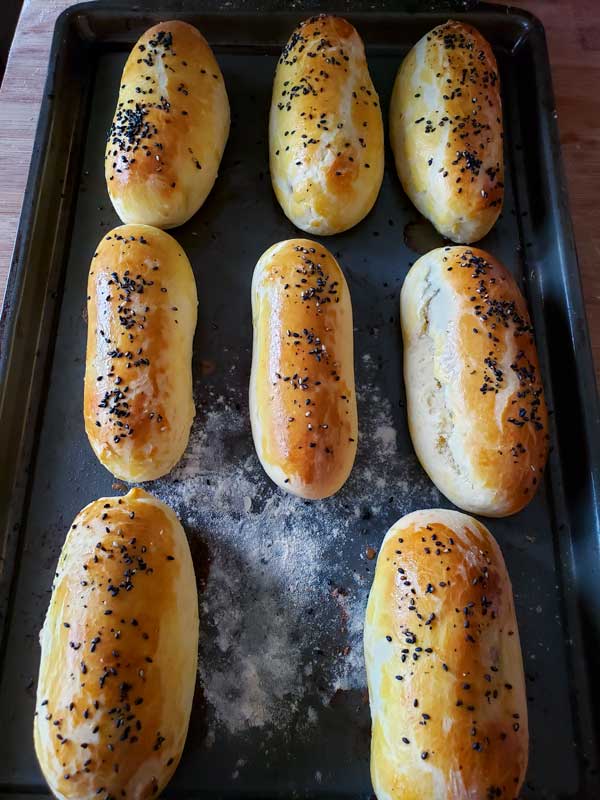
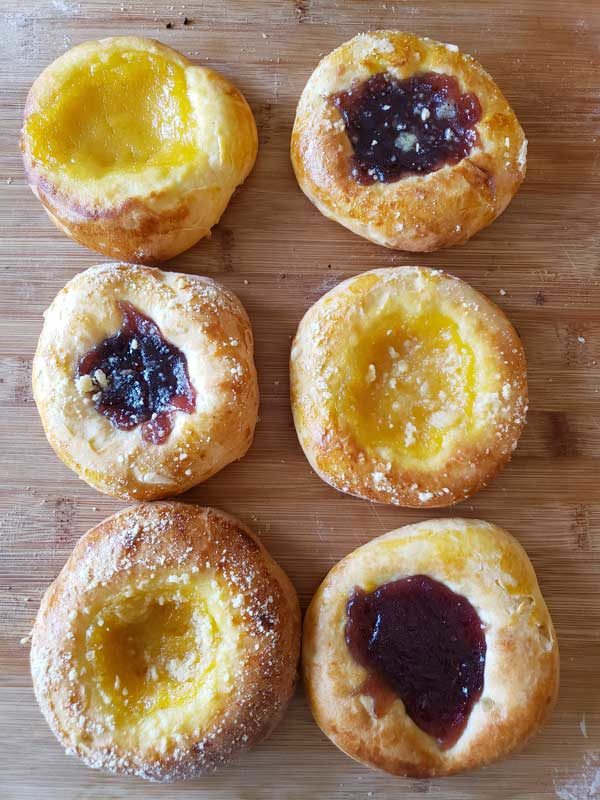
| Prep Time | 2 hours |
| Cook Time | 20 minutes |
| Servings |
Kolache (depending on size)
|
- 1/2 c lukewarm milk
- 2 1/4 tsp active dry yeast
- 1 tsp Sugar
- 1 c butter
- 1/2 c Sugar
- 4 egg yolks
- 4 egg whites beaten stiff
- 2 c cream milk, or half and half
- 5 1/2 c flour and more for handling/dusting
- 1 lemon for zest
- 1/2 tsp of vanilla
- Dash of cinnamon
- Dash of salt
- 1 egg yolk
- 1 tbsp cream or milk
Ingredients
Yeast:
Dough:
Egg wash:
Optional:
|

|
- Warm ½ cup of milk until lukewarm (a few seconds in the microwave). Add sugar and yeast to milk and let sit for about 10 minutes.
- Separate the egg whites, putting he yolks in a small bowl and whites in a stand mixer. Whisk egg whites until stiff peaks form. Scoop into another bowl and set aside.
- Cream butter in a stand mixer. Add sugar and four egg yolks one at a time until incorporated.
- Add the egg whites to the butter, then add the yeast mixture, cream, vanilla extract, lemon zest, cinnamon, salt, and flour. Beat with a dough hook until the dough comes together and has an elastic quality but is still a bit runny. The dough it quite sticky, so you can coat your hands in flour and lift the dough from the bottom of the bowl and sprinkle more flour there then top the dough with a dusting of flour. You may wish to transfer to another bowl or leave it in the stand mixing bowl.
- Set dough in a warm spot to let rise for about 1 hour, or until the dough has doubled in size.
- While the dough is rising, make the egg wash by mixing one egg yolk and 1 tbsp. of milk together in a small bowl. You may also prepare any additional filling and streusel topping if using (recipes below).
- When the dough has doubled, flour your hands (I find it helpful to have an extra bowl full of flour to dip my hands into when needed) and take the dough out by the tablespoonful. Roll into a ball with your hands, then press into a cookie shape, using fingers to make an indent in the center of the dough. You can do this while holding the dough or set the dough on a floured cutting board to do so.
- Grease a baking sheet and place the indented kolache with about ½-1 inch of space in between them. With a basting tool, coat the rounded edges of the kolache with the egg wash. This ensures that the dough has a beautiful golden-brown color.
- Fill the kolache with your fillings. Don’t forget you can mix and match fillings as well! Try a lemon curd and cream cheese filling, or a raspberry jam, lemon curd, and cream cheese filling, get creative.
- Once all the kolaches are filled, sprinkle with streusel topping (recipe below) if using and let the kolache rise for 30 minutes.
- Preheat the oven to 375. When the kolache have risen, bake for 10-15 minutes.
- Optionally, you can dust with powdered sugar immediately after taking out of the oven.
